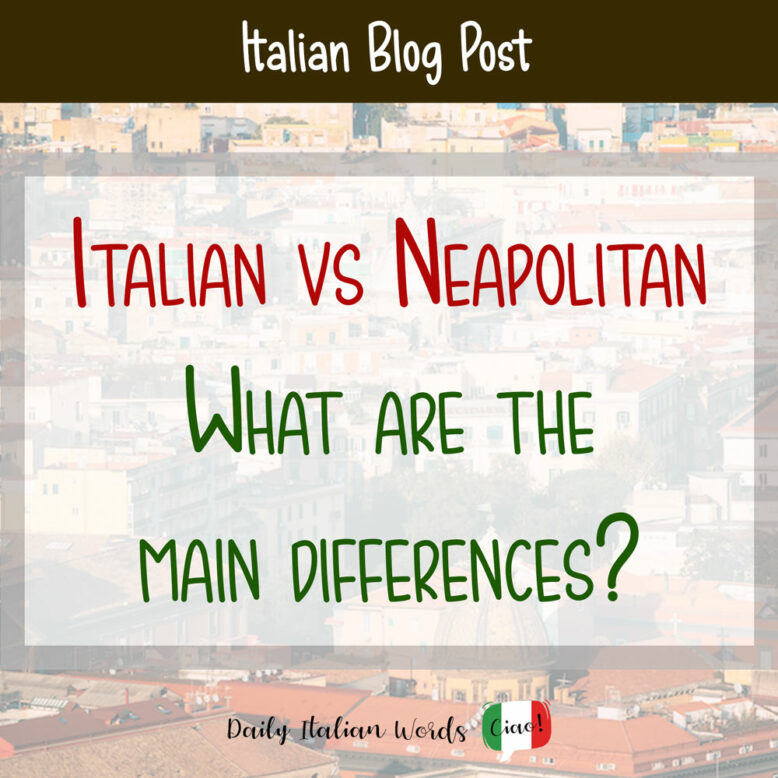When one thinks of Italy, the first language that undoubtably comes to mind is Italian, but did you know that multiple dialects and regional languages are spoken throughout the peninsula even to this day? This is because, up until the year 1861, Italy wasn’t a single unified nation but rather a conglomerate of states, each with its own culture, history and local language. This event is known as Il Risorgimento (literally “the Resurgence”) in Italian.
In this article, we’re going to be looking specifically at the Neapolitan language and how it compares to standard Italian in terms of its lexicon, grammar, pronunciation and more.

An Introduction to Neapolitan
Widely spoken in southern Italy, mainly throughout Campania, Molise, Basilicata, Abruzzo and North Apulia and Calabria, the Neapolitan language is still in use among many small communities but is not recognised as an official language. According to UNESCO, together with Sicilian, it is labelled as a Language in Danger of Extinction.
Likewise, Neapolitan is present within the Atlas of the World’s Languages in Danger. This is a catalogue of more than 2000 languages that lists the world’s most endangered tongues. Each language is accompanied by an ISO code issued by the International Organisation for Standardisation. The Neapolitan language, for example, is displayed with the code ISO 639-3 nap.
For this reason, we may say that the dialect is recognised as an interregional language in Italy, but not much more than that. De facto, the only official language of the Italian Peninsula is Italian.
Historical and ethnolinguistic background
Neapolitan, as well as Sicilian and the Italian language, is part of one main language family: the Romance language family. But unlike the others, this southern dialect belongs to the Italo-Dalmatian group, which is a multitude of Romance languages spoken in Southern Italy, Corsica, and in Croatia in the past.
Known in linguistics as an Intermediate Southern Dialect Group, Neapolitan has different variations due to its geographical area of usage. Indeed, it stretches from the south of the Marche to the north of Calabria including more than four Italian regions.
Historically speaking, the fatherland was located in Naples, or more specifically, in the Kingdom of Naples. During the Spanish rule, especially after the unification of the Kingdom of the Two Sicilies, the Neapolitan language began to substitute official Latin documents and started to become the main language for court assemblies.
Meanwhile, at the beginning of the XVI century, King Ferdinand the Catholic brought Castellan, the main language in Spain, to the Neapolitan court. But it was never imposed on its citizens, nor did it ever become the official language of the Kingdom.
The two languages shared linguistic features, such as vocabulary and language structure. And, whether it be due to common roots, the fact that both derive from Romance languages, or the influence of centuries of Spanish rule, the dialect shows clear similarities with Spanish Castellan.

The Schwa: The Germanic vowel in a Romance dialect
The main difference between Neapolitan and Italian is the presence of the Schwa, which in the International Phonetic Alphabet (IPA) is written as an upside-down e: ə. Wheres in Italian, it is not present, Neapolitan uses it as much as the English language does. And, particularly, its usage is related to the end of words. For instance, nuje (in English, “us”) will be read as /’nu:jə/.
nuje
“us” (English) – “noi” (Italian)
The schwa is a vowel that is pronounced without working the muscles of the mouth and the tongue very much. In English, it is used in words such as “worker” or “employer”.
The Neapolitan language makes consistent use of the schwa, making it a truly distinctive feature. Here are some examples:
- Lliévace /l’lje:vəʃə/ – (levaci in Italian) “take it (off) of us”
- O ppane /o p ‘pa:nə/ – (il pane in Italian) “the bread”
- U ggelat /u dʒe’latə/ – (il gelato in Italian) “the ice cream”
But this is only the first of many differences between Neapolitan and Italian.

Rhotacism and Consonant Doubling
Another peculiarity of the Neapolitan language is the usage of r instead of d when the latter is at the beginning of the word or in between two vowels. For instance, “to see” in Neapolitan is vedé which is pronounced as veré. This phenomenon is known as rhotacism, typical of northern countries and Germanic languages.
vedé
“to see” (English) – “vedere” (Italian)
At the same time, /nd/ as well as /nn/ are generally pronounced as a prolonged n: /n:/. For example, vattenn (“vattene” in Italian, “go away” in English) is /vatten:/ and in some places /vattən:/ too.
Vattenn!
“Go away!” (English) – “Vattene!” (Italian)
Consonant doubling is also present for words such as melon, which in Neapolitan is o’ mmellòn (in Italian: melone) or o’ppane (“bread“) which in Italian is simply pane.
This is something completely extraneous to the Italian language.

Verbal differences
The Neapolitan language has just one auxiliary verb for the active form, that is “to have”: avé. In Italian, by comparison, “to be” (essere) is also used for intransitive and reflexive verbs.
For example, “I went to Rome yesterday”, would be the following in Neapolitan:
Aggio juto a Rroma l’at ajere.
“Sono andato a Roma ieri.” (Italian) – “I went to Rome yesterday.” (English)
In Italian, you would say “sono andato” which uses the verb “to be“. Neapolitan, on the other hand, uses “to have” as can be seen by the conjugation: aggio.
In this southern Italian dialect, the omission of the subjunctive is also widespread. Most of the time, it is not used by native speakers who prefer the imperfect tense.
We can see the differences between the two in these examples:
Si fusse stato in Norvegia, avesse potuto veré l’laurora boreal.
“If I had been in Norway, I could have seen the Northern Lights.” (English)
“Se fossi stato in Norvegia, avrei potuto vedere l’aurora boreale.” (Italian)
Si ero ancora giovan, avesse scalat chella mundagn’.
“Were I still young, I would have climbed that mountain.” (English)
“Se fossi stato giovane, avrei scalato quella montagna.” (Italian)
In the first example, we can observe how the conditional tense too has changed and become the subjunctive. What in Italian is avrei potuto becomes avesse potuto, which is a shift between the two languages.

Did you know that…
One of the primary languages used in the famous Italian television series My Brilliant Friend (L’Amica Geniale in Italian) is Neapolitan. In the video clip below, you can hear it spoken by the main characters, Lila and Lenù, as well as the other supporting characters in the rione (neighbourhood).
Italian vs Neapolitan – Conclusion
Although Italian and Neapolitan have the same linguistic roots, the unique pronunciation of certain sounds, unfamiliar vowels such as the schwa, and conjugation differences make this dialect difficult to understand, even for people from different areas of southern Italy.
Still, it is a unique linguistic entity that deserves to be cherished and studied. But with the encroachment of standard Italian into all aspects of daily Italian life, Neapolitan could be in danger of falling silent forever.
About the author: Fabio Guarino
As a Linguist and Language Specialist, working as a Freelance Content Writer and SEO Marketer allows me to combine my passions and interests with my career. My favourite thing about working with languages is playing with words. And this is something I’ve always dreamed about since I started to wander the globe and study languages.

Fabio Guarino is a Linguist and Language Specialist who operates as a Freelance Content Writer and SEO Marketer. He considers himself fortunate to be able to blend his passion for his native language, Italian, along with English and Spanish, with his career.


